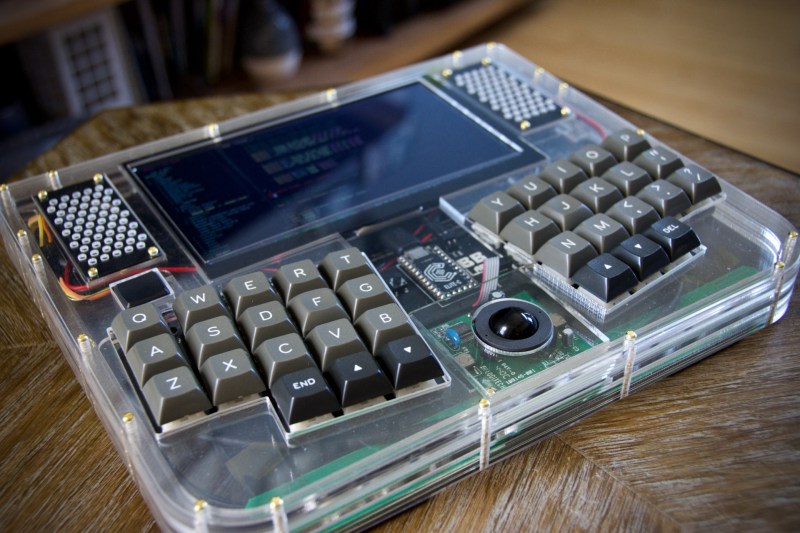When the universe tells you to build a cyberdeck, then build a cyberdeck you must. The lucky [Richard Sutherland] got an email from user-serviceable laptop purveyors Framework about the availability of their main board for use as a single-board computer. They agreed to send him a laptop and some extra modules as long as he promised to build something awesome with it. There was just one fabulous caveat: whatever design he came up with had to be released to the public.
[Richard] took this capable board with four USB ports and built an all-in-one that pays homage to the slab-style computers like the TRS-80 Model 100, which [Richard] really wanted as a kid. It looks lovely in layered acrylic and brass, and even though we pretty much always think that see-through is the best design choice you can make, transparency really works here. Tucked into those layers is a custom 36-key split running on an Elite-C microcontroller with Gazzew Boba U4 Silent-but-tactile switches, and a trackball in between. Be sure to take the build tour and check out all the process pictures.
Acrylic looks great and seems great on paper, but what about actual use? [Richard] put rubbery SKUF feet on the front, and a pair of repositionable feet on the back. Not only will it stay in place on the table, but he’ll be able to see the screen better and type at an angle greater than zero.
As cool as it would be to have Framedeck in the apocalypse, it will be hard to hide and could get looted. You might want to build something a bit more concealed.















I am always a bit wary of acrylic as it is (or I percieve it as) more brittle than ABS or other common enclosure plastics.
Yeah, polycarbonate would probably be a better choice.
Problematically brittle is probably overstating it – as the stuff is very elastic and durable really, though rather soft so I’d probably choose something else just so it won’t get scratched to death so easily (and because I don’t like working with it manually, understand it lases very nicely though).
The real challenge most of the time is working in the damn stuff rather than the finished parts durability, as once you create that tiny crack in it with your saw the propagation of that fracture can be pretty bad with that really tight focused stress point – but when finished well its mechanical properties as a material are pretty good.
Laser is the way to go with acrylic. Every bit as easy as sawing it is painful.
Beware of nasty and toxic fumes while cutting acrylique with a laser though. Work with proprer protection (mask, filtering) and active ventilation.
That is pretty much par for the course with a laser no? Even wood smoke/dust isn’t good to breath and can be very nasty with some woods, proper PPE and/or extractor on the cutter is a requirement just in general IMO.
“You might want to build something a bit more concealed.” – which links to an article on a deck built into an ammo case. TBH, which do you think is going to be grabbed on sight in the apocalypse, a high-tech-looking handheld that won’t have anything to connect to, or an AMMO BOX?
The one that looks like food.
https://www.instructables.com/Lunch-Box-Computer-with-Raspberry-Pi/
I tried that. I even cut a hole in the side with a rubber grommet to pass power cable to the RPI. But I found Wifi didn’t work so well in the metal box and I’d have to also pass an ethernet cable,.., decided to scrap that project at the time. I finally hit on a Pelican case that doesn’t have that problem.
I think I would have made the case slightly longer so you have a row of number keys. After all what is computing without numbers!
Otherwise neat project.
The up and down arrow keys are likely to raise/lower (think shift, alt, ctrl) the basic keys to get the “missing” characters. For example, pressing the left-side up arrow might turn the QWERTY row into the traditional number row.
This looks acutally good instead of the microscopic sized DevTerm… which is frankly an insult to the TRS-80 model 100.
I like the looks, but I suspect that if I raised the back feet high enough to read the screen, the incline of the keyboard(s) would be uncomfortable. But then, I never really used a Model 100 for more than typing a sentence or two.
maybe it would have been a nice feature to have a angle you could adjust the screen in.
This was a side-effect of twisted-nematic LCD displays in the age of the Tandy 100, and to a lesser extent with STN and TFT panels. With modern IPS displays, viewing angle is not a problem.